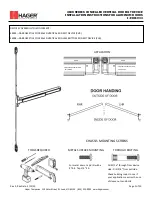
Fumes and hazardous gases
-
must not be breathed in
-
must be extracted from the working area using appropriate methods.
Ensure an adequate supply of fresh air. Ensure that there is a ventilation rate of at least
20 m³ per hour at all times.
Otherwise, a welding helmet with an air supply must be worn.
If there is any doubt about whether the extraction capacity is sufficient, the measured
toxic emission values should be compared with the permissible limit values.
The following components are responsible, amongst other things, for the degree of tox-
icity of welding fumes:
-
Metals used for the workpiece
-
Electrodes
-
Coatings
-
Cleaners, degreasers, etc.
-
Welding process used
The relevant material safety data sheets and manufacturer's specifications for the listed
components should therefore be studied carefully.
Recommendations for trade fair scenarios, risk management measures and for identify-
ing working conditions can be found on the European Welding Association website under
Health & Safety (https://european-welding.org).
Flammable vapours (e.g. solvent fumes) should be kept away from the arc's radiation
area.
Close the shielding gas cylinder valve or main gas supply if no welding is taking place.
Danger from fly-
ing sparks
Flying sparks may cause fires or explosions.
Never weld close to flammable materials.
Flammable materials must be at least 11 metres (36 ft. 1.07 in.) away from the arc, or
alternatively covered with an approved cover.
A suitable, tested fire extinguisher must be available and ready for use.
Sparks and pieces of hot metal may also get into adjacent areas through small gaps or
openings. Take appropriate precautions to prevent any danger of injury or fire.
Welding must not be performed in areas that are subject to fire or explosion or near
sealed tanks, vessels or pipes unless these have been prepared in accordance with the
relevant national and international standards.
Do not carry out welding on containers that are being or have been used to store gases,
propellants, mineral oils or similar products. Residues pose an explosive hazard.
Risks from mains
current and weld-
ing current
An electric shock is potentially life threatening and can be fatal.
Do not touch live parts either inside or outside the device.
During MIG/MAG welding and TIG welding, the welding wire, the wirespool, the feed
rollers and all pieces of metal that are in contact with the welding wire are live.
Always set the wirefeeder up on a sufficiently insulated surface or use a suitable, insu-
lated wirefeeder holder.
8
Содержание WF 15i
Страница 2: ......
Страница 16: ...16...
Страница 17: ...General 17...
Страница 18: ...18...
Страница 21: ...Controls connections and mechan ical components 21...
Страница 22: ...22...
Страница 29: ...OPT i WF Stand ard control panel 1 9 8 5 6 10 11 12 2 3 4 7 14 13 29 EN...
Страница 34: ...34...
Страница 35: ...Installation and commissioning 35...
Страница 36: ...36...
Страница 41: ...2 41 EN...
Страница 50: ...1 1 Contact pressure preferred values for U groove rollers Steel 4 5 CrNi 4 5 Tubular cored electrodes 2 3 50...
Страница 54: ...54...
Страница 55: ...Troubleshooting maintenance and disposal 55...
Страница 56: ...56...
Страница 63: ...Technical data 63...
Страница 64: ...64...
Страница 68: ...HP 70i HP PC Cable HD 70 Welding current at 10 min 40 C 104 F 60 ED 600 A 100 ED 500 A ED Duty cycle 68...
Страница 69: ...69 EN...
Страница 70: ...70...
Страница 71: ...71 EN...









































